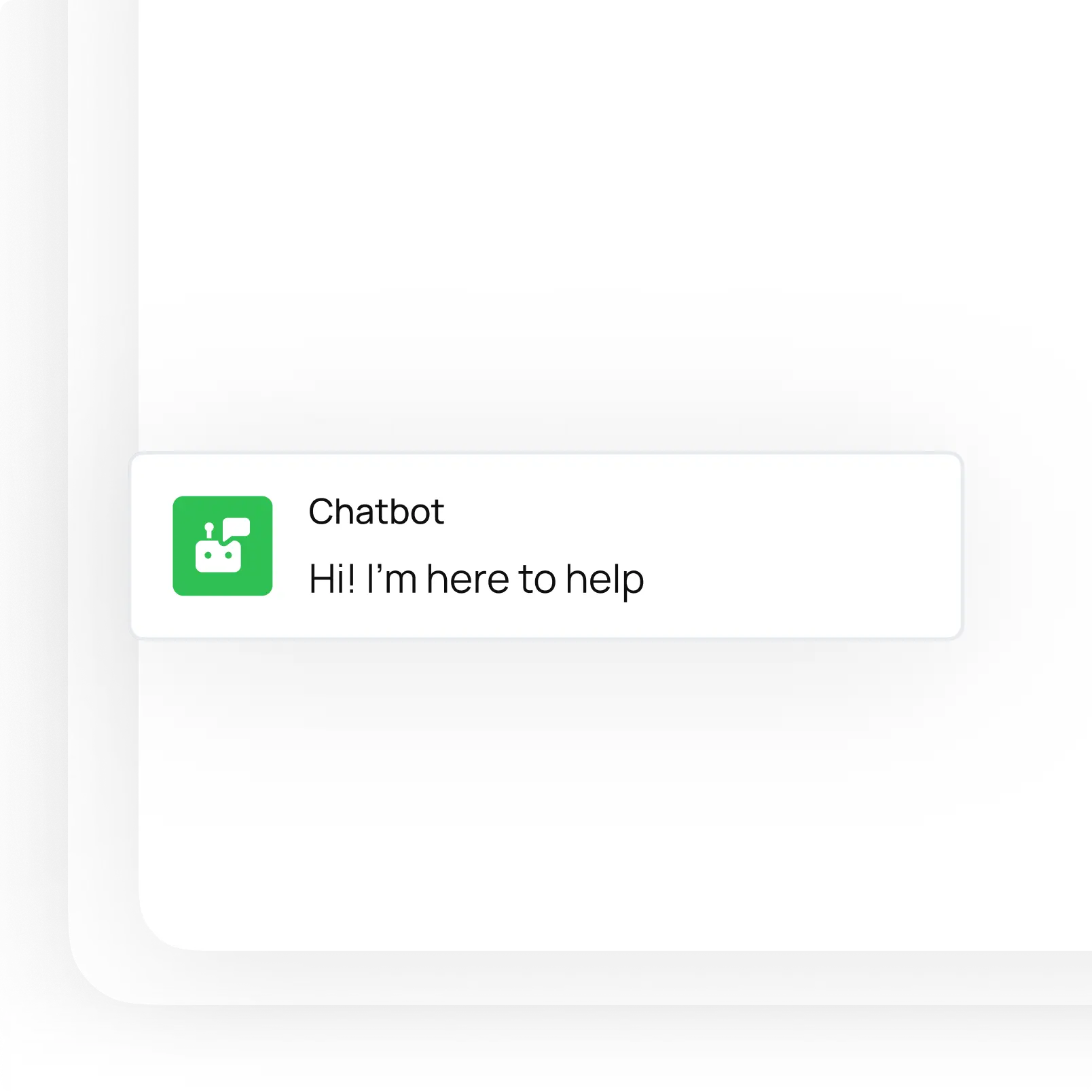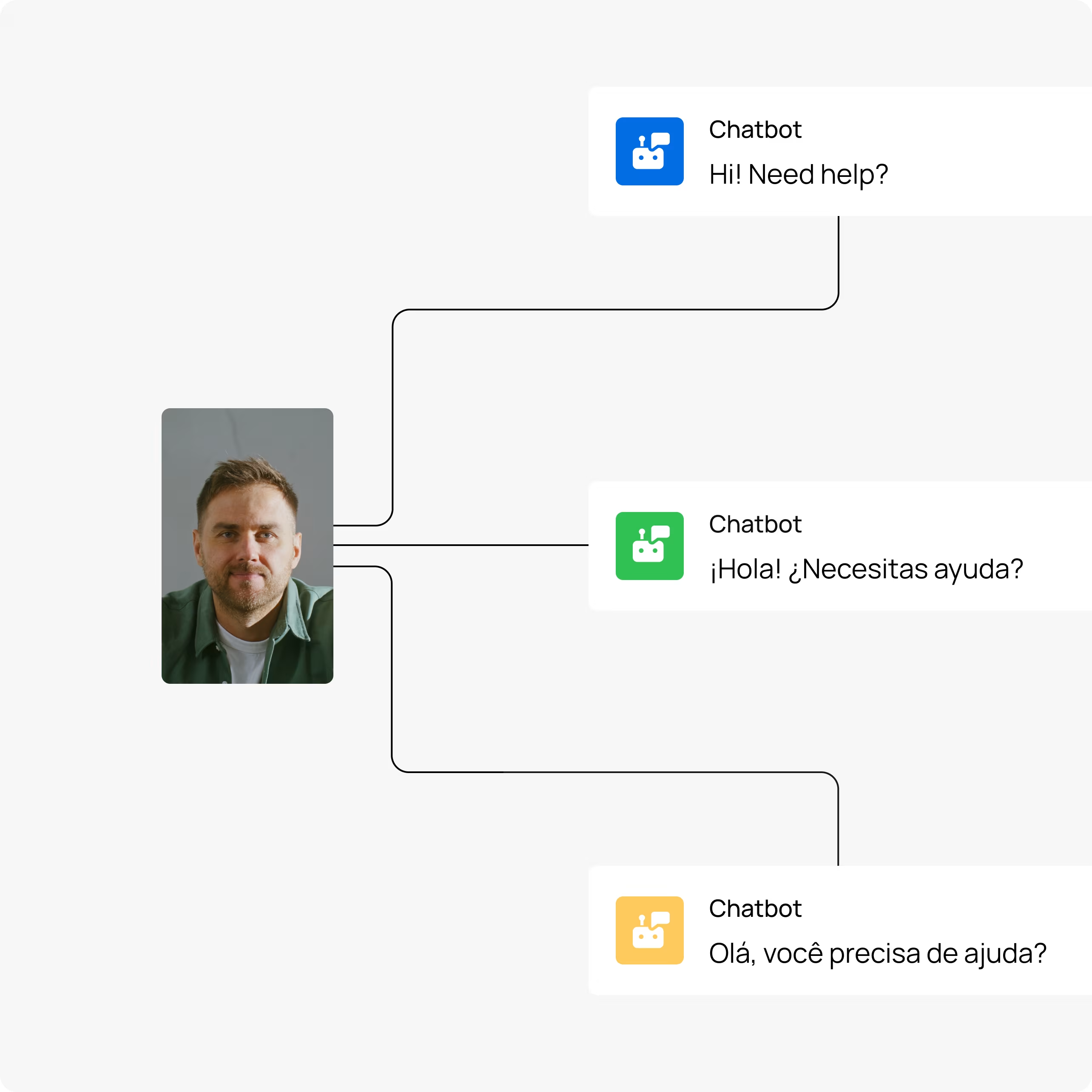Article
Omnichannel Chatbots: Everything You Need to Know


Introduction to Omnichannel Chatbots
Omnichannel chatbots represent the next step in this evolution in the way businesses interact with their customers, enabling businesses to engage with customers on their preferred channels—whether it’s websites, social media, messaging apps, or email—while maintaining a unified conversation history. This approach not only enhances customer satisfaction but also streamlines operations, making it a critical component of modern customer service.
The purpose of this blog is to provide a comprehensive guide to omnichannel chatbots, exploring their benefits, functionalities, and best practices for implementation. Whether you’re a business owner, a customer service professional, or a tech enthusiast, this guide will equip you with everything you need to know about leveraging omnichannel chatbots to elevate your customer experience.

1. What are Omnichannel Chatbots?
Omnichannel chatbots are AI-driven tools designed to interact with customers across multiple platforms seamlessly. Unlike traditional chatbots that operate within a single channel, omnichannel chatbots integrate with websites, social media, messaging apps, SMS, and more, ensuring a consistent and unified experience wherever the customer chooses to engage. They don’t just respond—they remember. Conversations flow effortlessly from one platform to another, picking up right where they left off, as if the customer never switched channels.
Key Features:
-
- Seamless Integration: They work across websites, social media platforms like Facebook and Instagram, messaging apps like WhatsApp and Telegram, email, SMS, and even voice assistants.
-
- Unified Conversations: They maintain context and history, so customers don’t have to repeat themselves when switching channels.
-
- Personalization: They use data from previous interactions to tailor responses, making every conversation feel relevant and human.
Omnichannel vs. Single-Channel Chatbots:
Traditional single-channel chatbots are limited. They operate in isolation, confined to one platform. If a customer starts a conversation on a website and then moves to Instagram, the chatbot can’t follow. It’s like starting over every time. Omnichannel chatbots, on the other hand, break down these barriers. They’re everywhere the customer is, providing a continuous, frictionless experience.
Benefits:
-
- For Businesses:
-
- Increased efficiency: One chatbot handles multiple channels, reducing the need for separate tools.
-
- Better customer insights: Unified data from all interactions helps businesses understand their customers more deeply.
-
- Higher customer retention: Seamless experiences keep customers coming back.
-
- For Businesses:
- For Customers:
-
- Convenience: They can switch channels without losing progress.
-
- Consistency: The same tone, style, and information across all platforms.
- Speed: Quick, accurate responses, no matter where they reach out.
-
2. How Do Omnichannel Chatbots Work?
-
- Explanation of the technology behind omnichannel chatbots:
-
- Natural Language Processing (NLP) and AI.
-
- Integration with CRM systems and data synchronization.
-
- Centralized dashboard for managing conversations across channels.
-
- Explanation of the technology behind omnichannel chatbots:
-
- Real-time communication and context preservation across platforms.
- Example use case: A customer starting a conversation on Facebook Messenger and continuing it via email.

3. What are the Four Types of Chatbots?
Chatbots come in different shapes and sizes, each designed to serve specific needs and levels of complexity. Understanding the four main types—rule-based, AI-powered, hybrid, and omnichannel—can help businesses choose the right tool for their goals. Here’s a breakdown of each type, their functionalities, and where they excel:
1. Rule-Based Chatbots
-
- How They Work: These chatbots operate on predefined scripts and decision trees. They follow a set of rules to respond to specific keywords or phrases. If a customer’s input matches a rule, the chatbot provides a corresponding answer. If not, it may struggle or default to a generic response.
-
- Functionality: Simple and straightforward, ideal for handling basic, repetitive tasks like answering FAQs or guiding users through a fixed process.
-
- Use Cases: Customer support for common queries, appointment scheduling, or basic product information.
-
- Limitations: Limited flexibility; they can’t handle complex or unexpected questions.
2. AI-Powered Chatbots
-
- How They Work: These chatbots use machine learning and Natural Language Processing (NLP) to understand and respond to user inputs dynamically. They learn from interactions, improving their accuracy and ability to handle nuanced conversations over time.
-
- Functionality: Capable of understanding context, intent, and even emotions, making them suitable for more complex interactions.
-
- Use Cases: Personalized customer support, product recommendations, and handling open-ended queries.
-
- Limitations: Require significant data and training to perform effectively.
3. Hybrid Chatbots
-
- How They Work: As the name suggests, hybrid chatbots combine the best of both worlds—rule-based and AI-powered systems. They use predefined scripts for straightforward tasks and switch to AI for more complex or ambiguous queries.
-
- Functionality: Versatile and efficient, offering a balance between simplicity and sophistication.
-
- Use Cases: Businesses that need to handle both routine tasks and complex interactions, such as e-commerce or banking.
-
- Limitations: Can be more complex to set up and maintain than purely rule-based or AI chatbots.
4. Omnichannel Chatbots
-
- How They Work: These chatbots operate seamlessly across multiple platforms, integrating with websites, social media, messaging apps, email, and more. They use AI and NLP to maintain context and continuity as customers switch between channels.
-
- Functionality: Provide a unified, consistent experience across all touchpoints, ensuring no disruption in communication.
-
- Use Cases: Businesses with a strong multichannel presence, such as retail, travel, or telecommunications, where customers expect seamless interactions.
-
- Limitations: Require robust integration with various platforms and systems, which can be resource-intensive.
Comparison of Functionalities and Use Cases:
| Type | Flexibility | Complexity | Best For |
| Rule-Based | Low | Low | Simple, repetitive tasks |
| AI-Powered | High | High | Complex, personalized interactions |
| Hybrid | Medium | Medium | Mixed tasks, balancing simplicity and sophistication |
| Omnichannel | High | High | Seamless, multichannel customer experiences |
Each type of chatbot has its place, but omnichannel chatbots stand out for their ability to deliver a cohesive, frictionless experience across every platform. They’re not just tools—they’re the future of customer engagement.

4. What is an Omnichannel Conversation?
An omnichannel conversation is a seamless interaction between a customer and a business that flows effortlessly across multiple platforms—websites, mobile apps, social media, email, SMS, and more. Unlike fragmented, single-channel conversations, omnichannel conversations maintain context and continuity, ensuring that every interaction feels connected and coherent, no matter where it takes place. Omnichannel marketing platforms like indigitall help organizations manage these interactions seamlessly.
The Importance of Context and Continuity:
In a world where customers switch between devices and platforms constantly, maintaining context is crucial. Imagine a customer starts a conversation on a website chat, asking about a product’s availability. Later, they switch to the business’s mobile app to check pricing or place an order. In an omnichannel conversation, the chatbot remembers the previous interaction, so the customer doesn’t have to repeat themselves. This continuity creates a smooth, frustration-free experience that builds trust and loyalty.
Example:
A customer visits an online store’s website and uses the chat feature to ask about a pair of shoes. The chatbot provides details on size, color options, and availability. Later, the customer opens the store’s mobile app to complete the purchase. Instead of starting over, the chatbot recognizes the customer, recalls the earlier conversation, and picks up right where they left off—suggesting the same pair of shoes and even offering a discount code. The transition is seamless, and the customer feels understood and valued.
Benefits for Customer Experience:
-
- Personalization:
Omnichannel conversations allow businesses to tailor interactions based on the customer’s history, preferences, and behavior. This level of personalization makes customers feel seen and appreciated, fostering a deeper connection with the brand.
- Personalization:
-
- Efficiency:
By eliminating the need to repeat information, omnichannel conversations save time for both customers and businesses. Customers get faster resolutions, and businesses can handle inquiries more effectively.
- Efficiency:
-
- Satisfaction:
A seamless, consistent experience across all channels boosts customer satisfaction. When interactions feel effortless and intuitive, customers are more likely to return and recommend the brand to others.
- Satisfaction:
Omnichannel conversations are more than just a feature—they’re a commitment to putting the customer first. By ensuring every interaction is connected, meaningful, and hassle-free, businesses can create experiences that resonate long after the conversation ends.
5. Key Benefits of Omnichannel Chatbots
Omnichannel chatbots are more than just a technological innovation—they’re a game-changer for businesses looking to elevate their customer experience and streamline operations. By integrating seamlessly across multiple platforms, these chatbots deliver tangible benefits that drive growth, efficiency, and customer satisfaction. Here are the key advantages:
1. Enhanced Customer Experience Through Seamless Interactions
Omnichannel chatbots ensure that every customer interaction is smooth and consistent, no matter where it happens. Whether a customer starts a conversation on a website, continues it on social media, and finishes it via email, the chatbot maintains context and continuity. This eliminates frustration, reduces repetition, and creates a cohesive experience that leaves customers feeling valued and understood.
2. Increased Customer Engagement Across Multiple Touchpoints
With omnichannel chatbots, businesses can meet customers wherever they are—on websites, mobile apps, messaging platforms, or even SMS. This omnipresence boosts engagement by making it easy for customers to connect on their preferred channels. By being accessible and responsive, businesses can foster stronger relationships and keep customers coming back.
3. Improved Operational Efficiency and Reduced Response Times
Omnichannel chatbots automate routine tasks and handle multiple conversations simultaneously, freeing up human agents to focus on more complex issues. This not only speeds up response times but also reduces operational costs. Customers get instant answers, and businesses can handle higher volumes of inquiries without compromising quality.
4. Data-Driven Insights for Better Decision-Making
By tracking interactions across all channels, omnichannel chatbots generate valuable data on customer behavior, preferences, and pain points. Businesses can use these insights to identify trends, optimize processes, and make informed decisions that enhance the overall customer experience. It’s like having a 360-degree view of your customers, all in one place.
5. Scalability for Businesses of All Sizes
Whether you’re a small startup or a large enterprise, omnichannel chatbots can scale to meet your needs. They can handle a handful of inquiries or thousands of simultaneous conversations without breaking a sweat. This scalability makes them a versatile solution for businesses at any stage of growth.
Why It Matters:
Omnichannel chatbots aren’t just about technology—they’re about creating meaningful connections. By delivering seamless experiences, boosting engagement, and driving efficiency, they empower businesses to meet the demands of today’s digital-first customers. In a world where convenience and personalization are king, omnichannel chatbots are the ultimate competitive advantage.
6. Challenges of Implementing Omnichannel Chatbots
While omnichannel chatbots offer significant benefits, implementing them isn’t without its hurdles. Businesses often face several challenges when integrating these advanced tools into their operations. Understanding these obstacles—and how to overcome them—is key to ensuring a successful deployment. Here are the most common challenges and their solutions:
1. Integration with Existing Systems and Platforms
-
- Challenge: Omnichannel chatbots need to work seamlessly with a variety of platforms, including websites, social media, CRMs, and messaging apps. Integrating these systems can be technically complex and time-consuming.
-
- Solution: Choose chatbot solutions with robust APIs and pre-built integrations for popular platforms. Work with experienced developers or vendors to ensure smooth integration and test thoroughly before going live.
2. Ensuring Data Privacy and Security
-
- Challenge: Handling customer data across multiple channels increases the risk of data breaches and privacy violations. Businesses must comply with regulations like GDPR or CCPA, which can be daunting.
-
- Solution: Implement strong encryption protocols, regularly audit security measures, and ensure compliance with relevant data protection laws. Use chatbots that prioritize data security and offer features like anonymization and secure data storage.
3. Maintaining Consistency and Context Across Channels
-
- Challenge: Keeping conversations consistent and contextually accurate as customers switch between channels can be difficult. A disjointed experience can frustrate customers and harm brand reputation.
-
- Solution: Use omnichannel chatbots with advanced NLP and AI capabilities to preserve context. Ensure all systems are synchronized in real time and regularly update the chatbot’s knowledge base to maintain accuracy.
4. Training and Optimizing AI Models for Accurate Responses
-
- Challenge: AI-powered chatbots require extensive training data to understand customer intent and provide accurate responses. Poorly trained chatbots can lead to misunderstandings and dissatisfied customers.
-
- Solution: Continuously train the chatbot using real customer interactions and feedback. Leverage machine learning to improve its performance over time. Monitor conversations regularly and make adjustments to refine its responses.
5. Balancing Automation with Human Touch
-
- Challenge: While chatbots excel at handling routine tasks, complex or emotionally charged situations may require human intervention. Over-reliance on automation can lead to impersonal experiences.
-
- Solution: Implement a hybrid approach where chatbots handle simple queries and escalate complex issues to human agents. Use sentiment analysis to detect when a customer might need a more personal touch.
6. Managing Customer Expectations
-
- Challenge: Customers may expect omnichannel chatbots to handle every query perfectly, which isn’t always realistic. Unmet expectations can lead to frustration.
-
- Solution: Set clear expectations by informing customers about the chatbot’s capabilities. Provide easy options to connect with human agents when needed, and use proactive messaging to guide customers through the process.
Overcoming the Challenges:
While the road to implementing omnichannel chatbots may have its bumps, the rewards far outweigh the challenges. By addressing these obstacles head-on—through careful planning, robust technology, and a customer-centric approach—businesses can unlock the full potential of omnichannel chatbots. The result? Happier customers, streamlined operations, and a stronger competitive edge in today’s digital landscape.
7. Industries Leveraging Omnichannel Chatbots
Omnichannel chatbots are transforming industries by delivering personalized, efficient, and seamless customer experiences. From retail to healthcare, businesses across sectors are harnessing the power of these AI-driven tools to meet evolving customer demands and stay ahead of the competition. Here’s how some key industries are leveraging omnichannel chatbots:
1. Retail
-
- Use Cases:
-
- Personalized Shopping Experiences: Chatbots recommend products based on browsing history, preferences, and past purchases, creating a tailored shopping journey.
-
- Order Tracking: Customers can check order status, track shipments, and receive updates across platforms like websites, apps, and messaging services.
-
- Use Cases:
-
- Impact: Enhanced customer satisfaction, increased sales, and reduced cart abandonment rates.
2. Banking
-
- Use Cases:
-
- Account Inquiries: Chatbots provide instant answers to questions about account balances, transaction history, and interest rates.
-
- Fraud Detection: They alert customers to suspicious activities and guide them through security measures in real time.
-
- Use Cases:
-
- Impact: Improved customer trust, faster query resolution, and reduced operational costs.
3. Healthcare
-
- Use Cases:
-
- Appointment Scheduling: Patients can book, reschedule, or cancel appointments via chatbots on websites, apps, or messaging platforms.
-
- Patient Support: Chatbots answer FAQs, provide medication reminders, and offer guidance on symptoms or treatments.
-
- Use Cases:
-
- Impact: Streamlined administrative processes, better patient engagement, and reduced wait times.
4. Travel
-
- Use Cases:
-
- Booking Assistance: Chatbots help customers find flights, hotels, and rental cars, offering personalized recommendations based on preferences.
-
- Real-Time Updates: They provide instant notifications about flight delays, gate changes, or booking confirmations across channels like SMS, email, and apps.
-
- Use Cases:
-
- Impact: Enhanced travel experiences, increased customer loyalty, and reduced stress for travelers.
5. E-commerce
-
- Use Cases:
-
- Customer Support: Chatbots handle common queries about returns, refunds, and product details, available 24/7 across platforms.
-
- Product Recommendations: They suggest items based on browsing behavior, purchase history, and customer preferences.
-
- Use Cases:
-
- Impact: Higher conversion rates, improved customer satisfaction, and reduced support costs.
Why It Matters:
Omnichannel chatbots are not limited to one industry—they’re a versatile solution that can adapt to the unique needs of any sector. By providing seamless, personalized, and efficient interactions, they help businesses build stronger relationships with their customers and drive growth. Whether it’s helping a shopper find the perfect product or guiding a patient through their healthcare journey, omnichannel chatbots are reshaping the way industries operate and connect with their audiences.
8. Best Practices for Implementing Omnichannel Chatbots
Implementing omnichannel chatbots can be a game-changer for businesses, but success depends on careful planning and execution. To maximize the benefits and avoid common pitfalls, it’s essential to follow proven best practices. Here’s a roadmap to help you deploy omnichannel chatbots effectively:
1. Define Clear Goals and Use Cases
-
- Why It Matters: Without a clear purpose, your chatbot can become a solution in search of a problem. Defining goals ensures the chatbot aligns with your business objectives.
-
- How to Do It: Identify specific pain points you want to address, such as reducing response times, improving customer satisfaction, or increasing sales. Create detailed use cases that outline how the chatbot will handle different scenarios.
2. Choose the Right Platform and Technology
-
- Why It Matters: Not all chatbot platforms are created equal. The right technology ensures scalability, flexibility, and seamless integration.
-
- How to Do It: Evaluate platforms based on features like NLP capabilities, multichannel support, and ease of integration. Consider factors like cost, scalability, and vendor support before making a decision.
3. Ensure Seamless Integration with Existing Tools and Systems
-
- Why It Matters: Omnichannel chatbots need to work harmoniously with your CRM, helpdesk, and other systems to deliver a unified experience.
-
- How to Do It: Use APIs and pre-built connectors to integrate the chatbot with your existing tools. Test thoroughly to ensure data flows smoothly between systems and that the chatbot can access relevant customer information in real time.
4. Focus on Personalization and Context Preservation
-
- Why It Matters: Customers expect interactions to feel personal and relevant. Preserving context across channels is key to delivering a seamless experience.
-
- How to Do It: Leverage customer data to tailor responses and recommendations. Use AI and NLP to maintain conversation history and context, ensuring customers don’t have to repeat themselves when switching channels.
5. Design Intuitive and User-Friendly Conversations
-
- Why It Matters: A poorly designed chatbot can frustrate users and drive them away. The conversation flow should feel natural and easy to navigate.
-
- How to Do It: Use clear, concise language and provide options for users to choose from (e.g., buttons or quick replies). Test the chatbot with real users to identify and fix any pain points in the conversation flow.
6. Continuously Monitor, Analyze, and Optimize Performance
-
- Why It Matters: Chatbots are not a “set it and forget it” solution. Regular monitoring and optimization are essential to keep them effective.
-
- How to Do It: Track key metrics like response accuracy, customer satisfaction, and resolution rates. Use analytics to identify areas for improvement and update the chatbot’s knowledge base and AI models regularly.
7. Provide an Easy Path to Human Support
-
- Why It Matters: While chatbots can handle many tasks, some situations require a human touch. Customers should never feel trapped in a chatbot conversation.
-
- How to Do It: Include clear options for users to escalate to a human agent when needed. Use sentiment analysis to detect frustration or confusion and automatically transfer the conversation to a live agent.
8. Educate and Train Your Team
-
- Why It Matters: Your team needs to understand how the chatbot works and how to support it effectively.
-
- How to Do It: Provide training for employees on managing and optimizing the chatbot. Ensure they know how to handle escalated issues and use the chatbot’s analytics to improve performance.
Why These Practices Matter:
Implementing omnichannel chatbots is not just about technology—it’s about creating a strategy that puts the customer first. By following these best practices, businesses can ensure their chatbots deliver value, enhance customer experiences, and drive long-term success. The result? A chatbot that doesn’t just work but works wonders.
9. Why Choose indigitall for Omnichannel Chatbots?
In a crowded market of chatbot solutions, indigitall stands out as a trusted partner for businesses looking to implement omnichannel chatbots that deliver real results. With a focus on innovation, scalability, and customer-centric design, indigitall offers a robust platform that empowers businesses to connect with their audiences seamlessly across multiple channels. Here’s why indigitall is the go-to choice for omnichannel chatbots:
Key Features of indigitall’s Omnichannel Chatbot Platform:
-
- Multi-Channel Integration:
indigitall’s platform supports a wide range of channels, including WhatsApp, Facebook Messenger, Instagram, email, SMS, and more. This ensures that businesses can meet customers wherever they are, providing a truly omnichannel experience.
- Multi-Channel Integration:
-
- Advanced AI and NLP Capabilities:
Powered by cutting-edge Artificial Intelligence (AI) and Natural Language Processing (NLP), indigitall’s chatbots understand customer intent, provide accurate responses, and learn from interactions to improve over time. This makes conversations feel natural and human-like.
- Advanced AI and NLP Capabilities:
-
- Scalability and Customization:
Whether you’re a small business or a large enterprise, indigitall’s platform is designed to scale with your needs. It offers customizable solutions tailored to your industry, goals, and customer preferences, ensuring a perfect fit for your business.
- Scalability and Customization:
-
- Real-Time Analytics and Insights:
indigitall provides a centralized dashboard that tracks key metrics like engagement rates, response times, and customer satisfaction. These insights help businesses optimize their chatbot performance and make data-driven decisions.
- Real-Time Analytics and Insights:
-
- Seamless Integration with Existing Systems:
The platform integrates effortlessly with CRMs, helpdesks, and other business tools, ensuring a unified flow of data and a consistent customer experience across all touchpoints.
- Seamless Integration with Existing Systems:
Case Studies and Success Stories:
-
- Retail: A leading fashion brand used indigitall’s omnichannel chatbot to provide personalized product recommendations and order tracking across WhatsApp and Instagram. The result? A 20% increase in sales and a 15% reduction in customer support costs.
-
- Banking: A major bank implemented indigitall’s chatbot to handle account inquiries and fraud detection via SMS and email. The solution reduced response times by 30% and improved customer satisfaction scores by 25%.
-
- Travel: A global travel agency leveraged indigitall’s platform to offer booking assistance and real-time updates across multiple channels. This led to a 40% increase in customer engagement and a 10% boost in repeat bookings.
Competitive Advantages of indigitall:
-
- Ease of Use: indigitall’s intuitive interface makes it easy for businesses to set up and manage their chatbots, even without technical expertise.
-
- Proven Expertise: With years of experience and a track record of success, indigitall has the knowledge and tools to deliver results.
-
- Customer-Centric Approach: indigitall prioritizes the customer experience, ensuring that every interaction feels personal, seamless, and meaningful.
-
- Global Reach: The platform supports multiple languages and regions, making it ideal for businesses with a global audience.
Why indigitall?
Choosing indigitall means choosing a partner that understands your business and your customers. With its advanced technology, multi-channel capabilities, and commitment to excellence, indigitall empowers businesses to create omnichannel experiences that drive engagement, loyalty, and growth. Whether you’re looking to streamline customer support, boost sales, or enhance brand loyalty, indigitall has the tools and expertise to make it happen.
In a world where customer expectations are higher than ever, indigitall is the solution that helps you not just meet but exceed them.












